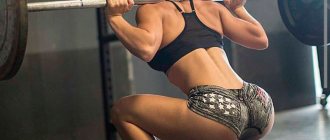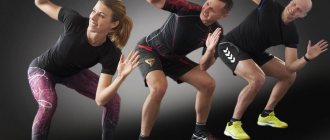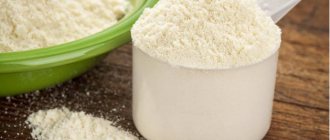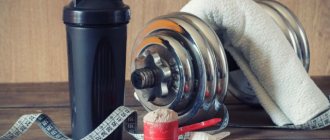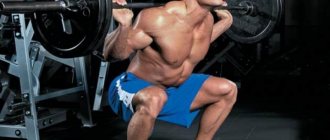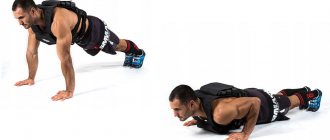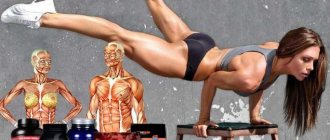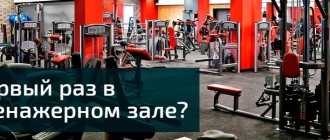Free weights and exercise machines, this topic has always caused a huge amount of controversy. Some argue that exercise machines are safer, you don’t need to think, and they are much more effective. Others, in turn, say that to achieve results you need to work only with free weights.
Training with free weights and working in a machine cannot be compared or put on the same level. This is because these are two completely different types of training. They differ in technique, severity, control and impact. In this article we will discuss the topic of training with free weights. Next time we'll talk about exercise equipment.
Training with free weights
The main difference between exercise machines and free weights is the difference in the impact on the muscles. When exercising on a machine, we pump the muscle in isolation. Exercises with free weights, in turn, load more muscles.
A training program with free weights is much more dangerous than working in machines. If you neglect the technique and warm-up, such an activity can lead to serious injuries. Free weights require a lot of attention and caution.
Notes
Hyperextension. Previously, during the two months of the first stage, we performed this exercise without weights. The lower back muscles have already become accustomed to such a load and most likely no longer react to it. This indicates that it is time to use additional weight in the exercise. The most convenient way for this purpose is a barbell disc, which you need to throw behind your head and hold on your shoulder blades.
Bars. Everything here is purely individual, but if you can do push-ups on the uneven bars more than 10 times, there is no point in doing it 15, 20, or more times, since you will be training endurance, and gaining weight for men involves slightly different manipulations. What to do? Take a belt, a chain, and do push-ups with weights, but as before - no more than 8-10 times. Where to begin? Hang a 2.5 kg disc on your belt. Still doing more than 10 times? Weigh 5 kg. Choose a weight for 8-10 reps.
Pull-ups. The same story as with dips. If you can do more than 10 pull-ups, hang a weight on your belt. Start the same way, for example with 2.5 kg. Adapt the weights according to the same principle - select the weight for the given number of repetitions. In this case, it is necessary to select the weight so that at the 8th, 9th repetition you already feel tired and tense, and the final repetition goes through strength.
Deadlift. As you noticed, in the first cycle it is absent, since we train our back on the same day as our legs and it is undesirable to perform two heavy basic exercises on the same day. Moreover, during the first cycle, using hyperextensions, you will sufficiently work the lumbar muscles, which are involved when performing deadlifts, without which, in turn, a training program for gaining muscle mass for a man would be incomplete.
Exercises with free weights
Training with free weights differs significantly from training on machines in that more muscles are involved. When working with free weights, you often have to maintain balance and control each approach. With proper attention to your training process, you can achieve quick results.
There are a lot of exercises with free weights. Almost all of them are done with either a barbell or dumbbells. You just need to choose the more pleasant ones and start acting. Free weights, first of all, imply sensitive control of each movement, do not forget about this.
Under the spoiler you can find several pictures with basic exercises when working with free weights.
Free weight exercises
What is a split?
A training principle called “split” means that we “split” the body into separate muscle groups and train them on different days. The advantage of this approach is that muscle groups have more time to recover and grow. While one muscle is resting, we train another. Doing just three workouts a week will lead to progress in the long run.
Classic split
The split can be made for 2-7 days. Also, for experienced athletes, a split program is acceptable, in which one muscle group is worked more than once a week. Our system is built differently, in which each muscle is loaded once a week . This ensures full recovery before your next workout. This approach will lead to the growth of high-quality muscle mass.
Most often, during split training, synergistic muscles are trained on the same day. For example, chest and triceps, back and biceps. The triceps get their share of the workload during any chest press exercise, and the biceps get their share of the workload during back rows. After performing the main load on a large muscle group, the athlete finishes off an already tired small muscle.
This split is discussed in detail in the following videos:
Alternative Approach
There is another approach - to train antagonist muscles at a time. For example, biceps after a chest workout or triceps after a back workout. It can be used from time to time, but not on an ongoing basis - not everyone is suitable for such heavy training.
Let's say you worked your biceps on Monday, and on Wednesday you do your back workout. In such conditions, it is important to pay a lot of attention to recovery - it is impossible to fully train your back if your biceps are still not recovered from Monday. Over time, this will lead to overtraining of small muscle groups, which will stop responding to any load and weaken. As a result, weak triceps will not allow you to set records in the bench press, weak biceps will not allow you to do normal pull-ups, etc. They will also not grow in such conditions.
Free weight machines
Free weights and exercise equipment you rarely see these two words side by side, but this also happens. Free weight machines are increasingly appearing in gyms. Each of them consists of special supports and a lever onto which the required weight is placed.
Free weight machines are usually not large compared to their brothers. Fortunately, it is no less effective. Working with free weights is a complex process, don't forget about it. Under the cut you can see some of the most popular exercise machines.
Free weight machines
Read also[edit | edit code]
- Power training
- Strength training techniques
- Strength training programs
- Annual training plan
- Periodization
- Anatomical adaptation
- Powerlifting training
- Special training Power training Isotonic training technique
- Ballistic training technique
- Resistance Power Training Technique
- Plyometric training
- Reactive power
Free weight training program
Chest, triceps:
Barbell press – 4x20 Dumbbell press – 3x12 Dumbbell flyes – 3x12 Dumbbell overhead raises – 4x20 Barbell overhead raises – 3x12
Back, biceps:
Deadlift – 4x20 Barbell row to the waist – 3x12 Dumbbell row to the waist – 4x12 Standing barbell raises – 4x20 Seated dumbbell raises – 4x15
Legs, shoulders:
Squat with barbell – 4x20 Lunges with dumbbells/barbell – 4x15 Barbell overhead raises – 4x12 Dumbbell overhead raises – 4x12
Sources[edit | edit code]
- Owino, V., et al. 2001 Age-related loss of skeletal muscle function and the disability to express the autocrine form of insulin-like growth factor-1 (MGF) in response to mechanical overload FEBS Letters 505 (2): 259-63.
- Goldspink, G. 2005- Mechanical signals, IGF-I gene splicing, and muscle adaptation. Physiology 20:232–38.
- Ahtiainen, J.P., et al. 2011. Recovery after heavy resistance exercise and skeletal muscle androgen receptor and insulin-like growth factor-I isoform expression in strength trained men. Journal of Strength and Conditioning Research 25(3): 767-77. doi:10.1519/JSC.0b013e318202e449.
- Liu, Y., et al. 2008. Response of growth and myogenic factors in human skeletal muscle to strength training. British Journal of Sports Medicine 42(12): 989-93. doi: 10.1136/bjsm.2007.045518.
- Hameed, M., et al. 2008. Effects of eccentric cycling exercise on IGF-I splice variant expression in the muscles of young and elderly people. Scandinavian Journal of Medicine and Science in Sports 18 (4): 447-52.
- Roschel, H., et al. 2011. Effect of eccentric exercise velocity on akt/mtor/p70(s6k) signaling in human skeletal muscle. Applied Physiology Nutrition and Metabolism 36(2):283-90. doi:10.1139/hl0-lll.
- Goldspink, G. 2012. Age-related loss of muscle mass and strength./4gmg Ites 2012:158279 doi: 10.1155/2012/158279.
- Schoenfeld, B. J. 2012. Does exercise-induced muscle damage play a role in skeletal muscle hypertrophy? Journal of Strength and Conditioning Research 26(5): 1441-53. doi:10.1519/JSC.0b013e31824f207e.
- Sjogaard, G., et al. 1985. Water and ion shifts in skeletal muscle of humans with intense dynamic knee extension. American Journal of Physiology 248 (2 pt 2): R190-96.
- Febbraio, MA, and Pedersen, BK 2005. Contraction-induced myokine production and release: Is skeletal muscle an endocrine organ? Exercise and Sport Sciences Reviews 33(3): 114-19.
- Homberger, T. A., et al. 2006. The role of phospholipase D and phosphatidic acid in the mechanical activation of mTOR signaling in skeletal muscle. Proceedings of the National Academy of Science of the United States of America 103 (12): 4741-46.
How to create a beautiful relief?
The period of gaining muscle mass is followed by careful work on the relief, with the goal of emphasizing the beautiful outlines of the muscles. At this time, a special program is carried out, combining it with drying - the process of burning subcutaneous fat while maintaining maximum muscle mass.
Professional bodybuilders dry most often twice a year: before the spring and autumn seasons. Accordingly, during the period of gaining muscle mass, you need to maintain a more or less dry shape - this way drying will proceed much easier. Two to three months is just enough to get in shape: reduce your waist size, improve muscle separation, make your stomach more prominent. The priority task during the drying period is to get rid of the subcutaneous fat layer to the maximum, while maintaining muscle volume and strength indicators.
This is achieved by creating a calorie deficit - we begin to spend more energy than we receive. This consists of the following components:
- switching to a low-carb diet;
- increasing training intensity;
- adding cardio exercise.
Naturally, these are only the general and most common components of drying. All athletes are individual, some manage to do without cardio, while others dry out on the same amount of carbohydrates that others gain. But the general trend is exactly this - cutting back on the amount of carbohydrates (and there is often a period right before a competition when their amount can reach zero), small changes in the training program and adding aerobic training.
There will certainly be small losses in muscle mass, but with proper nutrition with plenty of protein, they can be minimized. Pros use anabolic steroids for the same purpose. For amateurs, of course, it is better to do without them, although the loss in muscles will most likely be greater.
As for daily caloric intake, you need a deficit of 10-20% of the daily value. If you cut back even more, the body will try to get rid of the muscle first. The main thing is to accurately measure the number of calories, and not do it “by eye”. Kitchen scales and online food diaries will be of great help in such a situation. In nutrition, the main emphasis should be on proteins - 2-3 grams per kg of weight. It is advisable that all carbohydrates be complex. At the initial stage of drying, there should be at least 1.5 g per kg of weight.
Next, we will tell you what a relief training program should be like in the gym, how to correctly create it, and how to work on muscle definition at home.
© IEGOR LIASHENKO — stock.adobe.com
